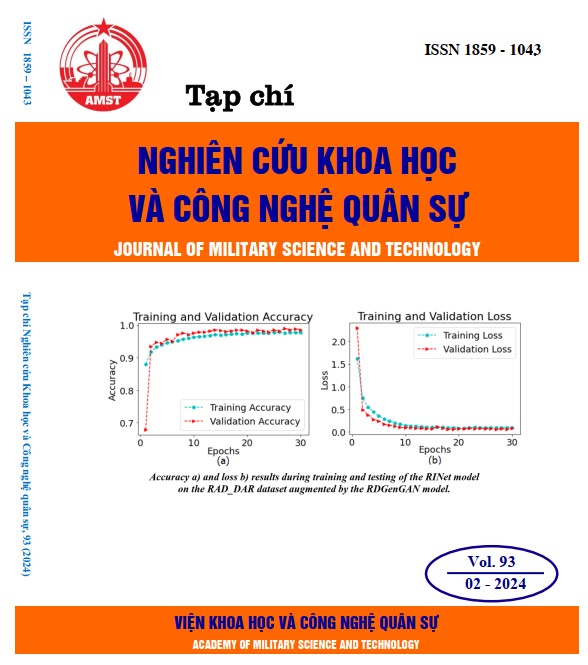Design and simulation of a coplanar capacitive sensor for non-destructive thin-film dielectric measurement
551 viewsDOI:
https://doi.org/10.54939/1859-1043.j.mst.93.2024.55-62Keywords:
Capacitive sensor; Coplanar sensor; Non-contact thin-film thickness measurement; Non-destructive thin-film thickness measurement.Abstract
This article presents a different design of coplanar capacitive sensors for application in non-destructive thin film dielectric measurement with high performance and minimal cost. Another difference in this sensor design is that to reduce parasitic components and common noise, the capacitive sensor structure is designed to include a reference capacitor and a sensing capacitor. Using this structure, the dielectric of the thin film can be estimated through the unbalanced capacitance generated between the two signals from the reference capacitor and the sensing capacitor. Two electrode structures were researched, simulated, and the interdigital structure with the highest performance was selected. Simulations were conducted using a Polyethylene (PE) thin film with dielectric varying from 1.375 to 3.19 and a thickness of 40 µm to study the working principle of the sensor. Simulation results show the linearity of the sensor's output capacitance corresponding to different dielectrics. The sensitivity of the sensor is 20.86 fF/1 dielectric unit and 178.96 fF/1 dielectric unit for thin films with thicknesses of 10 µm and 120 µm, respectively. Simulation results demonstrate that this sensor has high potential for application in dielectric measurement of thin films for military and biomedical applications.
References
[1]. James R. Baker-Jarvis et al, “Measuring the permittivity and permeability of lossy materials: solids, liquids, metals, building materials, and negative-index materials,” U.S. Department of Commerce, National Institute of Standards and Technology, pp102-104, (2005).
[2]. Bartley, Philip G.; Begley, Shelley B., “A new free-space calibration technique for materials measurement,” IEEE International Instrumentation and Measurement Technology Conference (I2MTC) - Graz, Austria, pp. 47–51, (2012). DOI: https://doi.org/10.1109/I2MTC.2012.6229351
[3]. Ozturk, Turgut; Elhawil, Amna; Düğenci, Muharrem; Ünal, İlhami; Uluer, İhsan, “Extracting the dielectric constant of materials using ABC-based ANNs and NRW algorithms,” Journal of Electromagnetic Waves and Applications, Vol. 30, No.13, pp.1785–1799, (2016). DOI: https://doi.org/10.1080/09205071.2016.1215266
[4]. A. R. Kerr et al, “Compact waveguide loads and fts measurements at room temperature and 5 k,” The National Radio Astronomy Observatory, ALMA MEMO #494, pp.1-10, (2004).
[5]. Halpern, Mark; Gush, Herbert P.; Wishnow, Edward; De Cosmo, Vittorio, “Far infrared transmission of dielectrics at cryogenic and room temperatures: glass, Fluorogold, Eccosorb, Stycast, and various plastics,” Optical Society of America, Vol. 25, No.4, pp.565-570, (1986). DOI: https://doi.org/10.1364/AO.25.000565
[6]. A MAHARAJ and R LEYLAND, “The dielectric constant as a means of assessing the properties of road construction materials,” Proceedings of the 29th Southern African Transport Conference (SATC), Pretoria, South Africa, pp.487-498, (2010).
[7]. S Gabriel et al, “The dielectric properties of biological tissues: III.Parametric models for the dielectric spectrum of tissues,” Physics in Medicine & Biology, Vol.41, No.11, pp.2271–2293, (1996). DOI: https://doi.org/10.1088/0031-9155/41/11/003
[8]. L. de Brouckere; G. Offergeld, “The dielectric properties of solid polymers,” Journal of Polymer Science, Vol. 30, No.121, pp.105–118, (1958). DOI: https://doi.org/10.1002/pol.1958.1203012109
[9]. Y.K. Kulshrestha; A.P. Srivastava, “Dielectric properties of polystyrene and polystyrene-chloranil,” Thin Solid Films, Printedinthe Netherlands, Vol.71, No.1, pp.41–45, (1980). DOI: https://doi.org/10.1016/0040-6090(80)90181-9
[10]. T. Seghier and F. Benabed, “Dielectric Proprieties Determination of High Density Polyethylene (HDPE) by Dielectric Spectroscopy,” International Journal of Materials, Mechanics and Manufacturing, Vol. 3, No. 2, pp.121-124, (2015). DOI: https://doi.org/10.7763/IJMMM.2015.V3.179
[11]. Ahmed Dabbak, Sameh; Illias, Hazlee; Ang, Bee; Abdul Latiff, Nurul; Makmud, Mohamad, “Electrical Properties of Polyethylene/Polypropylene Compounds for High-Voltage Insulation,” Energies, Vol.11, No.6, pp.1-13, (2018). DOI: https://doi.org/10.3390/en11061448
[12]. Tran Thi, Ha Thuy; Nguyen Dac, Hai; Ngoc, An Nguyen; Nguyen Ngoc, Dung; Thai, Le Van; Thanh Bui, Tung, –“A 3D Printed Two-axis Tilt Angle Capacitive Sensor,” in Conference: 2018 IEEE Seventh International Conference on Communications and Electronics (ICCE), pp. 191-195, (2018). DOI: https://doi.org/10.1109/CCE.2018.8465753
[13]. Dac, Hai Nguyen; Thuy, Ha Tran Thi; Quoc, Tuan Vu; Van, Thai Le; Duc, Trinh Chu; Bui, Tung Thanh; Ngoc, An Nguyen, “Study on Design Optimization of a Symmetry Two-Axis Tilt Angle Capacitive Sensor,” IETE. J. Res., pp. 264-271, (2020). DOI: https://doi.org/10.1080/03772063.2020.1816224
[14]. Hai, Nguyen Dac; Tuan, Vu Quoc; Loc, Do Quang; Hai, Nguyen Hoang; Trinh, Chu Duc, “Differential C4D sensor for conductive and non-conductive fluidic channel,” Microsystem Technologies., Vol. 22, no. 10, pp. 2511–2520, (2016). DOI: https://doi.org/10.1007/s00542-015-2586-4
[15]. Chen, Jian Z.; Darhuber, Anton A.; Troian, Sandra M.; Wagner, Sigurd,“Capacitive sensing of droplets for microfluidic devices based on thermocapillary actuation,” Lab on a Chip., Vol. 4, no. 5, pp. 473–480, (2004).
[16]. Caglar Elbuken; Tomasz Glawdel; Danny Chan; Carolyn L. Ren, “Detection of microdroplet size and speed using capacitive sensors,” Sensors and Actuators A: Physical., Vol. 171, no. 2, pp. 55–62, (2011). DOI: https://doi.org/10.1016/j.sna.2011.07.007
[17]. Chen, Jian Z.; Darhuber, Anton A.; Troian, Sandra M.; Wagner, Sigurd, “Capacitive sensing of droplets for microfluidic devices based on thermocapillary actuation,” Lab on a Chip, Vol.4, No.5, pp.473-480, (2004). DOI: https://doi.org/10.1039/b315815b







